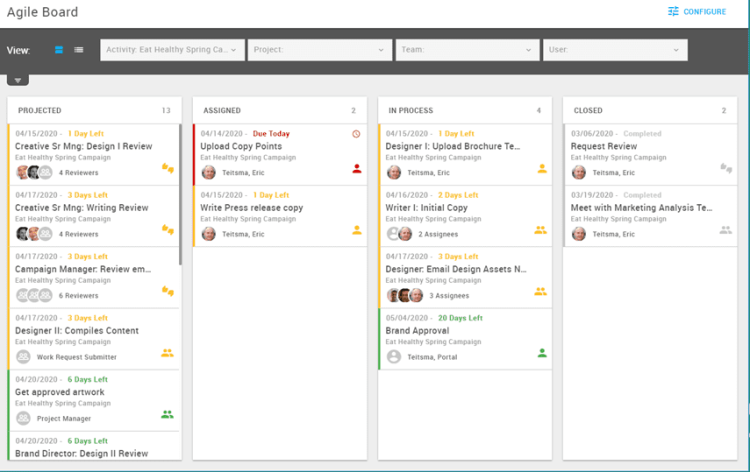Like a lot of people living under a stay-at-home order, I?ve recently tried my hand at baking my own bread. I was shocked to discover that something I?ve always thought as complex is usually just a deceptively simple combination of three basic ingredients: yeast, flour, and water.
Along the same lines, going Agile at the enterprise-level is really just a matter of putting a few ingredients together: structure, speed, and stamina.
But there is another striking similarity between going Agile and breadmaking: the various levels of maturity.
If you’re just starting out with baking, you can create delicious, basic bread by mixing together those three ingredients I mentioned earlier. As you bake more and more loaves, your enhanced ability to pull the different levers of the three ingredients at the right moments will allow you to create more sophisticated bread, rivaling what you could get in a bakery or in a restaurant. In other words, through all that trial and error, you gain experience.
Similarly, as a marketing leader, you can learn to pull the levers of structure, speed, and stamina at just the right moments to align to your marketing strategy, make mid-year shifts to adapt to what’s happening in market, or support organizational change.
Now, if you need a basic overview of Agile, start with these resources. But once you?ve got the basics down, it’s time to dig a little deeper into the ingredients and discover what makes them critical to your transformation.
Core Marketing Ingredient #1: Structure
According to the 2020 State of Agile survey from AgileSherpas and Aprimo, more marketers than ever before are interested in Agile marketing to help them win now and win more in the future. That said, most marketers also rate ‘Lack of Training? as a top barrier to changing the way work gets done.
 44% of marketers say lack of training or knowledge about Agile approaches is the top barrier to changing the way they work.
44% of marketers say lack of training or knowledge about Agile approaches is the top barrier to changing the way they work.
With that in mind, let’s look at the most common ways organizations structure their Agile teams.
Lean Marketing
Often associated with manufacturing, lean principles?putting in feedback loops, data collection, iteration (process improvement), and validation?are penetrating marketing organizations. This style is best suited for marketing work that is consistent and repeatable because success is often measured by improvements in efficiency.
Is it really a good fit for marketing? Speaking as someone who started their career in manufacturing at a company where lean was a part of their DNA, if you do a lot of the (relatively) same marketing at scale, it’s a great fit. Marketing that generally conforms to regulations or a specific format are good candidates for this approach. According to the survey, 17% of marketers have chosen this structure for their teams.
Scrum
This style of working originated with our friends over in development and IT. It’s popular for marketing because it breaks down very large projects into smaller deliverables that are made available more often?doesn’t that sound great!
The most common traits of scrum are sprints (small deliverables), retrospectives (analysis of a sprint after it’s completed), and a backlog at various stages (for example, what’s coming next after current work is done). But it’s a highly structured approach and generally requires bringing on full-time employees specifically to manage the process.
I find this is a good fit for organizations with a strong tech pedigree, particularly where there is sufficient experience and peer groups that can help guide this transition. But the outcomes are undeniable: you get structure, you get disciplined execution, faster time to market, and the benefits of retrospectives.
Kanban
If you were to grab an average marketer off the street and ask them to describe Agile Marketing, this is probably what they would describe because it’s so visual.
 Agile Marketing Feature from Aprimo Productivity Management.
Agile Marketing Feature from Aprimo Productivity Management.
Even though you need a board to make Agile a reality, you also need some discipline as you get bigger.
First, it’s easy for small teams that are all sitting next to each other to have a physical board and keep it up to date (?Hey David, did you finish that task? Yes? I’ll move the card for you?). But what do you do if you’re a large team or a distributed team? Imagine assigning someone the task to move cards on the board but they have to do the same thing a couple hundred times a day. Not very efficient. Larger teams need a digital solution. Adding to this, what do you do if you’re trying to get multiple teams to go Agile as part of a department-wide initiative? You’ll fill up a single board really fast and leadership won’t be able to make heads or tails of anything on it. Not ideal.
Next, you need to be able to manage your workload. I know when I?ve personally used a Kanban board, my ?Projects? column gets long really fast and I never get control of it. And what happens if you’re suddenly slammed and your ?Current Assignments? gets a lot longer? Small teams have no trouble sitting down and hashing out a plan, but it’s hard to quickly sift through the workloads of hundreds or thousands of inter-dependent marketing resources.
That’s a big reason why a pure Kanban approach is only used by 11% of marketing teams. It’s good to dip into, but Kanban boards struggle to remain effective at scale.
Scrumban
I hear you saying, ?Wait, I like a lot of what Scrum had to offer and I like the visual nature of Kanban. So why don’t I combine the two?? Many marketers have had the same thought. Clever creatures that they are, they call the combination ‘scrumban.?
According to the 2020 State of Agile Survey, though, this is actually the least popular format, used by less than 10% of teams. The primary reason for this is even though Kanban and scrum are very complementary, because of the way marketing teams tend to interpret and adopt the methodologies, outcomes are often less than the sum of the two.
Scrum introduces discipline, structure, and typically requires more headcount as part of a commitment to the cause. On the flipside, Kanban is typically associated as a little looser, very visual way to manage work. Therefore, simply combining the two without a very solid approach, will usually just result in nothing better than before.
Hybrid
There are baking recipes in books and online that give you step-by-step guides on how make a particular kind of bread. But every person is different, with different tastes and uses for the bread they’re making. Agile Marketing is really no different and that’s why we typically see each company applying a unique hybrid of what they learn on their journey that satisfies the core of Agile:
-
- Efficiency
- Cycle Time
- Throughput
The data from the 2020 State of Agile Survey backs this up as, too.
 Most marketers use a unique hybrid of Agile methods
Most marketers use a unique hybrid of Agile methods
 Unique marketing activities cause marketers to deploy a hybrid Agile approach
Unique marketing activities cause marketers to deploy a hybrid Agile approach
 58% of marketers use the daily standup Agile practice on their teams.
58% of marketers use the daily standup Agile practice on their teams.
?Hybrid? is one way to think about a unique combination of Agile practices. We think about it as ?Bring your Own Agile.?
Bring Your Own Agile
If you’re just starting out, the best practice is to pick one of the formal Agile methods to get experience in new ways of working, new ways to design work, and new ways to communicate. But just like baking, as you get more experience, you’ll notice things that work better for your company, you’ll start to find areas to innovate, and you’ll get closer to your ideal new way of working. The 2020 State of Agile survey is a great place to start your journey and so is our Agile Marketing resource hub, so get your hands into those ingredients and start cooking.


